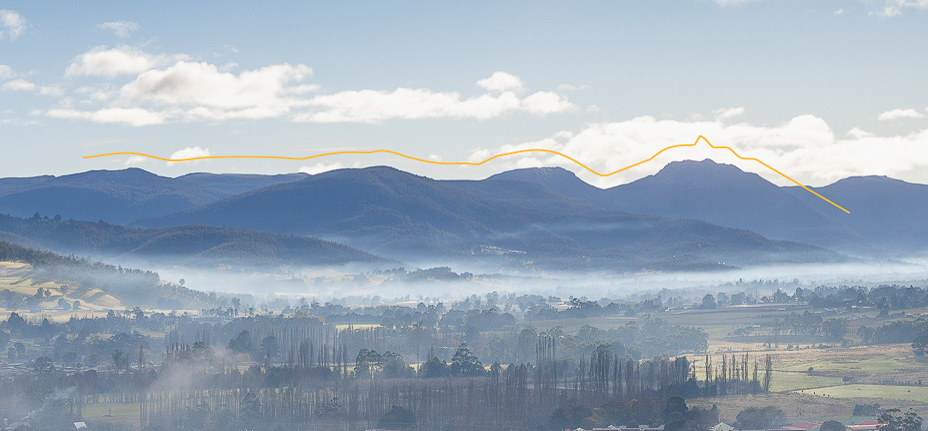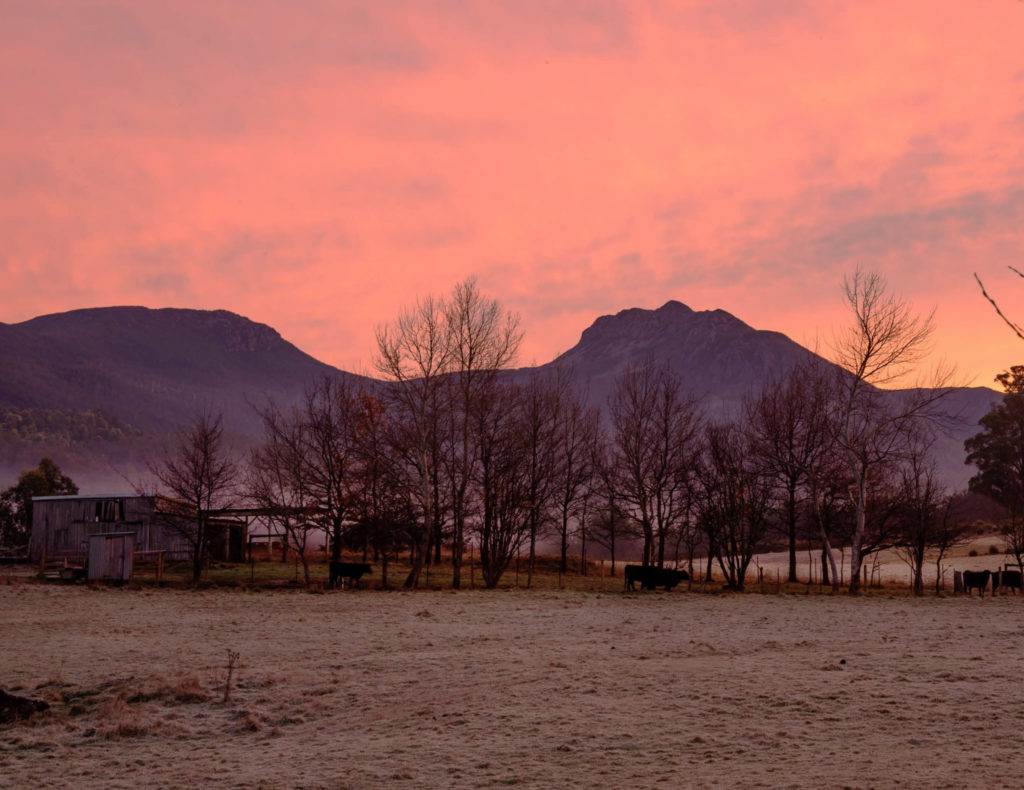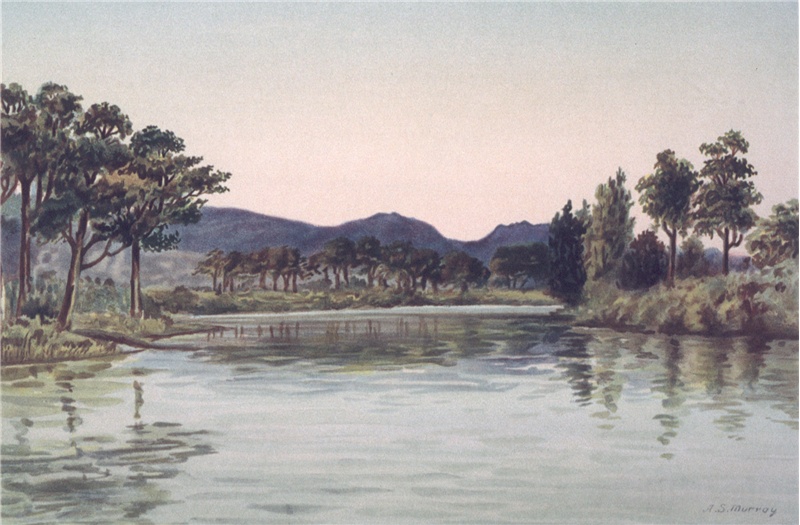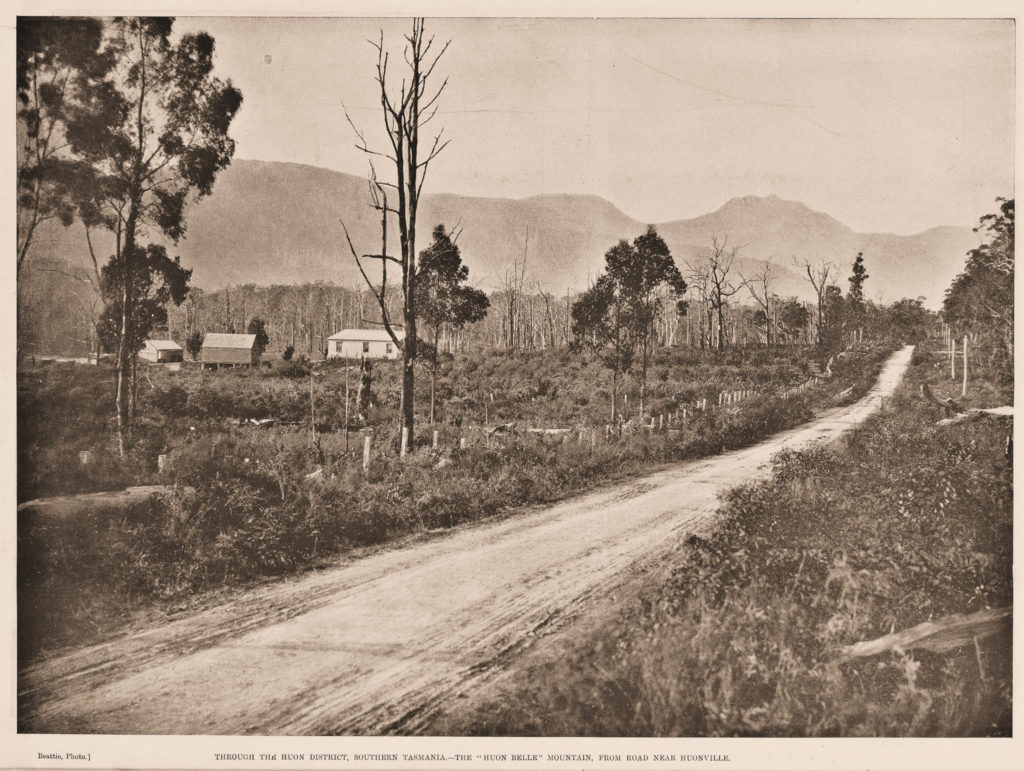It’s ironic that the dolerite rock that was violently forced up thousands of years ago formed such a serene romantic southern sphinx. Her hair lying back towards Mt Wellington (Kunanyi), her resting profile flowing leftwards along the ranges – brow, nose, lips and breasts – Sleeping Beauty is a constant and welcoming landmark for travellers and sailors looking north from the Huon and Channel.
Locals say Sleeping Beauty looks different through the seasons, whether lit up by a warming sun, shrouded by a misty veil or framed by dramatic clouds. The poetic name for the bordering mountain range is a lovely sentinel over the acres of Huon Valley orchards, nestled under her reclining profile.
Sleeping Beauty is composed of the two mountains Collins Bonnet (1260m) named after the founding Lieutenant Governor of the Colony of Van Diemen’s Land, who established Hobart in 1804 and Trestle Mountain (1100m). Collins Bonnet forms her lovely head while Trestle Mountain forms the bosom (see outline below).

There are few more striking mountain features in the southern half of Tasmania. Locals often shorten her to just ‘Beauty’. Beauty receives the gentle touch of the makeup brush’s golden light in the morning and afternoon, in the cooler months her profile is even more pronounced as she is more backlit.

Both peaks are climbable. Bushwalker Mark Hanna explains ‘It’s a very long and steep climb, particularly if doing both peaks, but features great mountain and valley views, both during the walk and from the peaks. The Collins Bonnet peak (Sleeping Beauty’s nose) has a true summit feeling, and provides spectacular views of the surrounding range, Huon and Derwent valleys and more distant mountains on clear days. Many well-known Tasmanian peaks can be seen in a broad arc from the north to south through west.’
Mark suggests ‘To get there, travel to the intersection of Mountain River Road and the Huon Highway at Grove. Travel 8km up Mountain River Road, avoiding all side turns and private roads and entrances, until the end of the road is reached. This is at the point where a sign indicates the start of the Mountain River Trail, and is located adjacent to two private driveways. Park well off the road.’
Trestle Mountain and Collins Bonnet can also be accessed through a Tasmanian Wilderness Experiences guided tour which takes the route leaving from Collinsvale. The track on the northern edge of the Wellington Range, passes through a magnificent temperate rainforest. I strongly recommend this guided option for less experienced walkers.
Over the years many adventurers have made the treck. In 1940, J.A.B Forster with two companions, described in The Mercury newspaper
‘As we struggled up over broken rocks and talus, what harsh features she really had. We sought not to awaken her as did the prince of “Sleeping Beauty” to which name she also lays claim, but took advantage of the tip of her nose to rest our limbs wearied by a stiff climb.’
Fourth-generation orchardist Andrew Smith suggests ‘Sleeping Beauty extracts the rain and influences the hail that we can get around Christmas. The ranges do cause rain events, nurturing the orchards by catching the rain before the system coming from the west coast gets to the east coast.’
Older Huon folk recall when Sleeping Beauty’s first epithet was the ‘Huon Belle’. This name was the inspiration for the Huon ketch of that name which became famous in Tasmanian regattas in the 1880s, built by a Mr. Colin Walker on the shores of Port Cygnet Bay. Perhaps returning weary victors toasted with a sassafras lager to their beautiful namesake whilst gleeful orchardists raised a ripe winter apple to her perched lips. In pioneering days Beauty offered a farewell blessing to elopers who travelled the bridal track to Hobart to be wed.

One of Tasmania’s most respected early documentary photographers, John Watt Beattie photographed and publicised the Huon Belle in the 1900s, in his popular ‘magic lantern shows’ and accompanying lectures, which brought to public view images of wild and dramatic Tasmanian landscape scenes.

Poems to Sleeping Beauty
In 2004, Mountain River local, poet, performer, storyteller and author, Phillip Rush wrote this poem in response to the view from his studio:
Sleeping Beauty - from our place we see her worn and rugged face. But when the chilling breezes bring the Antarctic’s icy sting, Our view is one of pure delight; A Sleeping princess, clothed in white!
The following poem was found in The Bulletin in 1913 by M.Hooker who fell under Beauty’s charm:
Spellbound amid her sleeping sentinels, Through the long ages dreams the Huon Belle - A silent face amid the mountains grey, Lying with stony features upward turned. Heedless of heat or cold or the white snow That every winter makes her forehead hoar. Long hath she slept, so long that wind-blown trees Grown bolder in the stillness, have up climbed O’er the wan cheek and, in wild whispers low. Breathe their strange music to the silent lips That answer not but guard their secret well, Lost in the solitude of silver clouds.
From the Huon Times Fri 30 Jan 1920 page 4 (uncredited)
HUON BELLE In outline bold and sharp relief when the noonday sun is shining. A solar blue transparent veil envelopes her form reclining; Beneath the Southern Cross she lies a proud disdainful figure. Like as a cast of antique mould in human shape though bigger; So silent and profound her gaze with never a sigh or murmur. The seasons come with steady gate But this sphinx masks all fervour. She scorns all mundane suitors, pink dawns red sunsets glows Have blended their affections pure as her marching snows; And when the moonbeams stealing around this form sublime. The stars add planes stooping put put forth their hapless prime; All blizzards' fierce intentions with storm clouds rambling round Imprints their loving pressure mark time but gain no ground. Tell pray what art thou dreaming. Star-gazing in the dome. Which elements finds favor in such romantic home. Does hoar-frost soothe your passion or lunar rainbows plead in accents more engaging and still have you the need. Of thunder and its rattle to chase dull gloom away. Till seraphims embrace you to free your soul from clay; Lie still, fair form with silent moan and time's effacing fingers Will purge the dross and let you flee where true ethereal lingers.
Written in 1940s by FC Meyer in book, Bijoux of Mountains and Valleys of Tasmania
Mount Huon Belle Above the bushland’s hilly chain, Where rangers made their story, Men do leave the dusty plain, Repeating like a lory; The Huon Belle in greatest pain Reveals to thee her beauty, Sleeping beauties are in vain Escaping nature’s glory. Above the woodland’s fairest peak, Where roamers seek adventure, Women also strong and weak Enjoy a hiking tour; The Huon Belle looks rather bleak, Yet haunted by l’amour, Sleeping beauties are unique, When posing on a tour.
